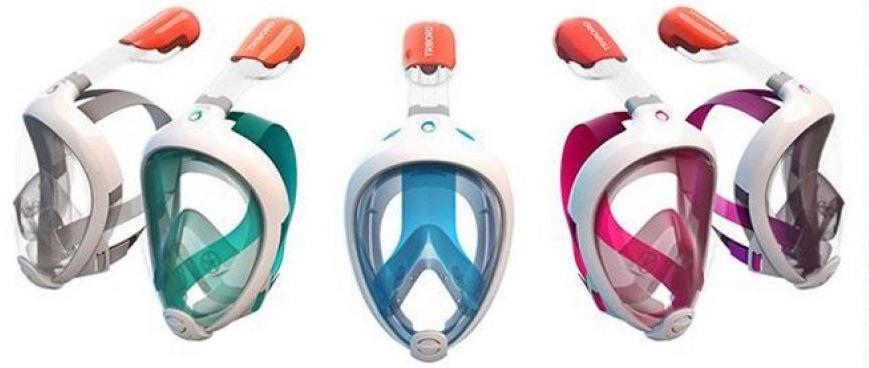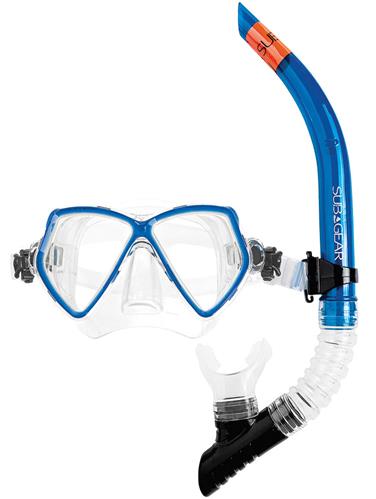
When you are out there snorkeling, you'll see that guy in the water who keeps stopping to take off his mask?
The reason is because no one showed that snorkeler how to choose his snorkeling mask properly.
After reading this webpage content, you will know what to look for in a snorkeling mask.
Most Important Thing to Look for in a Snorkeling Mask
Priority Number One - A Proper Fitting Snorkeling Mask
When choosing your snorkeling mask from all the options on the shelf or in from the Rental Vendors box, your first and foremost criteria should always be a proper fit to your face. The rubber-like portion of the mask that makes contact with your face is called the skirt. The skirts sole purpose is to make a water tight seal against your skin. A skirt that doesn’t properly seal against your face is certain to cause a whole host of problems like fogging, leaking and even fatigue.
If you have even the slightest slow leak between the skirt of the mask and your face, you’ll be on the surface of the ocean emptying the sea water from your mask more so than you are actually snorkeling. Treading water vertically takes a lot more energy than floating horizontally. You may find yourself out of breath and getting worn out rather quickly.
Another important thing to remember is that "lifting" your mask away from your face to empty the ocean water from it will also make your mask fog. When you pull the snorkel mask and skirt from your face, new moist outside air will enter the mask and start to condense against the colder inside lens surface. The more new air that’s introduced, the more moisture there now is within your mask to condense upon your lens.
Please, never choose a mask solely because of the way it looks on the shelf or because someone else told you that it’s the “latest and greatest in snorkel mask technology". Be sure to choose a properly fitting mask.
How to Find a Mask That Fits You
You are trying to find a snorkelig mask that fits your face like a ball to a glove, secure and snug on all sides. If it fits the way it supposed to, you will almost forget you have it on while snorkeling. Please keep in mind that everyone has a uniquely shaped face, therefore there is no single snorkel mask model that is best for everyone. The following test can ensure your make the right mask selectionf or yourself:
When you try on a mask, start the testing process by holding your breath, but don't inhale or exhale. Gently place the mask up against your face and press very slightly with consistent pressure. Now let go of the mask with your hands. A well-fitting mask will stick to your face without you having to hold it in place. Remember that you should not inhale through your nostrils when you release the mask from your face. of the mask. Anybody can make a mask stick to their face by inhaling through their nose hard enough. Ultimately, the better the mask seals to your face in the store (out of the water) the less likely you'll have any leaks when moving your head in the water. No matter how much you think you like the look of a Snorkel Mask as you take it off the shelf, if it doesn't pass our test, find another mask.
A well-fitting mask will should feel very comfortable and not be putting any undue pressure on your skull or face. You should not have to tighten the mask strap to keep it from leaking. When putting on the mask strap, you need only tighten it enough to keep the mask from sliding or shifting on your face when you turn your head. The majority of the water tight seal should be coming from the skirt of the snorkel mask, not and over-cranked strap.
Also, if you have facial hair, it may be tough to get a good skirt seal to your face and you will most likely experience some leakage. If you have longer head hair, it is alwasy best if you can wet your hair and slick it back out of your face prior to putting your mask on. Now, as you do put your mask onto your face, you can run your finger around the edge of the mask skirt to make sure no hair is caught under it.
Other consideration when choosing a Snorkeling Mask
When Choosing a Snorkeling Mask, you should also consider:
If you are shopping for your Snorkeling Gear and you happen to find a few different masks that you think fit equally well, then you should definitely choose the mask that has the features or attributes that you like. Just always keep in mind that any considerations should come second to first finding a mask that fits your face properly.
A Wide Skirt – If you are trying on a few different masks, take a look at the edge of the skirt; this is the portion of the skirt that’s actually going to make contact with your skin. As you look at the different masks, you’ll notice the skirts come in varying widths. As a rule of thumb, the more of the edge that’s in contact with your skin, the more likely it will make a good seal to your face.
Materials – If you’re going to purchase your own mask, definitely be sure that the skirt is made from silicone. Rubber skirts become brittle and crack, falling apart over time. Silicone masks will last for many years and in some cases many decades.
Peripheral Visibility – With your snorkel mask on your face and while keeping your head completely still, roll your eyes in all directions and check your peripheral vision. If you try on a few masks, you’ll most likely notice that some masks will make you feel tunnel-visioned or compressed, while other masks may make you feel like you’re sitting in front of an open window.
No Fog Lens – Many snorkel manufacturers make special “no fog” lenses. Although no mask lens is actually guranteed “no fog”, they are definitely extremely “low fog”. There is a minimum amount of preparation needed to keep your lenses crystal clear for the duration of your dive.
Vision Enhancing Coatings – Some snorkel mask lenses are made to increase the underwater clarity during less-than-perfect lighting conditions. These types of lenses have a special tinting that makes images crisper and more clear by reducing the glare and filtering out certain wavelengths of incoming light. These lenses actually do make a difference for your vision, so when you see them in the dive shop you’ll know what they are.
Low Volume – Each time you dive under the surface, the weight of the water above you compresses the air inside your snorkel mask. Therefore, the deeper you go, the more water there is above you, and hend additional added pressure. To compensate for this pressure increase within your mask, you must exhale slightly through your nose, using the air held in your lungs to fill your mask and equalize the pressure. There are such things as "Low volume masks", which are designed with the lens closer to your face to reduce the inside air volume. With these Low Volume Masks there is less air volume within the mask, so naturally there is much less volume that you will have to refill by exhaling through your nose. This benefits are that you keep more air inside your lungs, where it's needed. You are exhale much less into your mask, so it is less likely that it will fog.
Top 3 Ways to Keep Your Mask From Fogging
- Be sure your mask is properly fitted for your face - If you have no idea what I’m talking about, PLEASE see the sections above “What to look for in a snorkeling mask” and “How to find a mask that fits you”.
- You should avoid taking your mask on and off while snorkeling - The general rule is, that once you put your snorkeling mask on to your face, leave it on. Every time that you pull the mask away from your face, you are just leting in more new moist air that is going to condense against the cold inside lens surface. For the same reasons, you should also avoid exhaling excessively through your nose while snorkeling. Some nasal exhalation is necessary while diving to re-pressurize your mask (please see the section above “Low volume”). While snorkeling, nasal breathing should be kept to a minimum.
- Use Mask De-Fog - Defog is any substance that is applied to the inside of your mask lens to prevent condensation from occuring. De-Fog solutions are a grea invention and they definitely work You are sure to find De-Fog in almost any dive shop.























 Snorkeling Masks
Snorkeling Masks 



